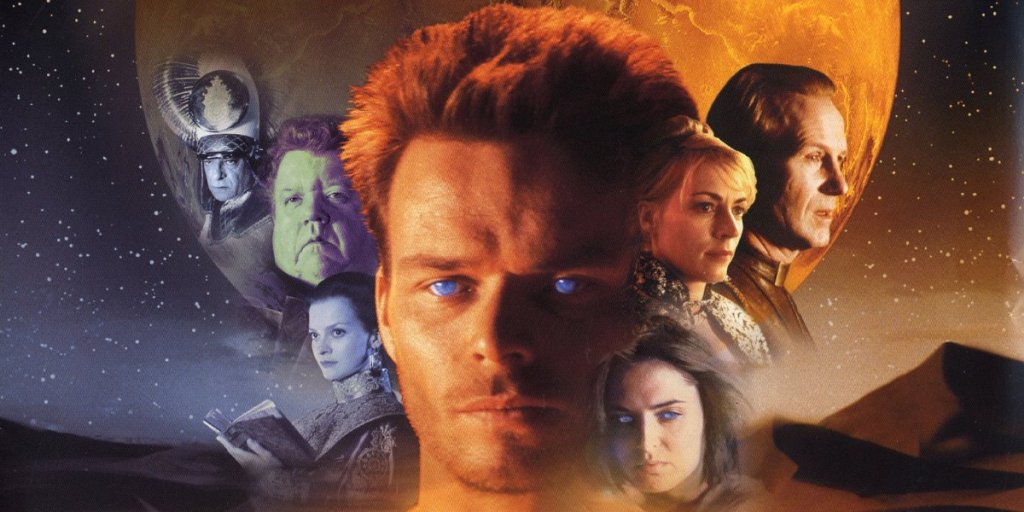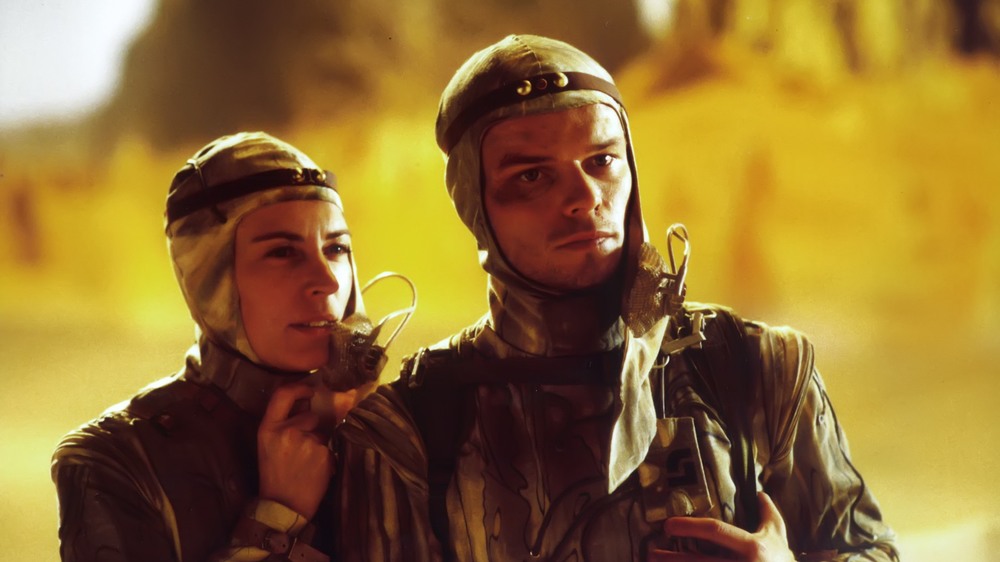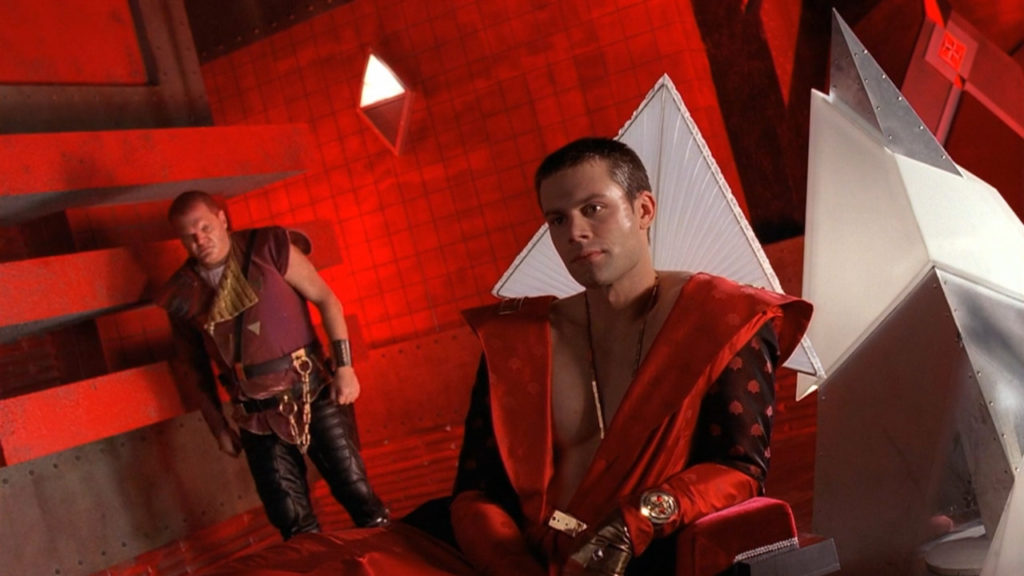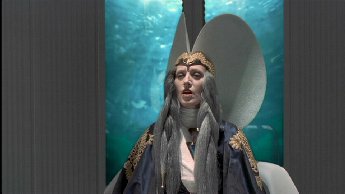 Poster art for the Sci-Fi Channels' 2000 miniseries based on Frank Herbert's 'Dune'
Poster art for the Sci-Fi Channels' 2000 miniseries based on Frank Herbert's 'Dune'
In the commentary section of Artisan's 3-Disc DVD Special Edition Director's Cut of Dune, writer-director John Harrison and his crew discuss the various aspects of pre- and post-production. Executive produced by Richard P. Rubinstein and Mitchell Galin, produced by David Kappes, and edited by Harry B. Miller III, the driving force behind this Special Edition was Harrison's love for author Frank Herbert's original vision and pervasive worldview.
"But because of different broadcast requirements required around the world," Harrison wrote in his Director's Statement, "the definitive version of what we created has never been released until now" (circa the year 2002, that is). In his longer-by-30-minutes letterboxed cut, "scenes are restored and minor structural adjustments have been made which, in my estimation, make it the complete rendering of the story."
What a refreshing point of view! If only that sound bit of advice had trickled down to the likes of David Lynch and the De Laurentiis production team for their own expanded, mind-numbingly static, three-hour edition. Truth to tell, that elephantine reinvigoration of Dune was fated to bite the proverbial dust from which it came, extended scenes or not.
"Like many of my generation, I read and was strongly influenced by Herbert's epic novel when I was young. [Here, here!] A serious, often difficult meditation on political, social, and religious ideas, Dune is not simply a book of fantasy and adventure. It's a book of philosophy. Still, I always believed this story could be accessible to a wide audience. It may be classified [as] sci-fi, but I prefer to think of it as a romantic epic in the classic tradition; a timeless myth-fable, after all."
There's an inherent structural sense to Dune, that of a classic Greek tragedy (or, if you prefer, coming-of-age story), in between the lines of social commentary and/or interpretation, of that we can vouch for. And of the Hero of a Thousand Faces, i.e. Joseph Campbell's path-breaking research into mythology, which heavily influenced a fledgling producer-writer-director named George Lucas for his Star Wars saga.
Harrison continued: "I also believe the themes of Dune are more relevant today than they were when Herbert first wrote the book. The world in which we now live is far closer to the universe he created than the bipolar cold-war world of the fifties and sixties. And I consider it my extreme good fortune and enormous responsibility to have had the chance to adapt the book. Along the way, I gained a deeper and richer appreciation of the world of Dune than I ever had before."

One couldn't agree more. Indeed, our world has tipped ever-closer to the chaotic, for-profit business enterprises tied to governmental entities that pervade the Dune ethos than at any time in our history. "But while preparing to direct it, I also realized this Dune needed its own visual signature, its own singular identity. There has been a lot of discussion and speculation about the hyperbolized theatrical, almost operatic style of this version. It was a risky, unusual choice for a sci-fi epic. But without the artistry and the intrepid support of [the entire cast and crew]..., without the wealth of talent in all the roles, large and small, this Dune would have been simply ordinary."
Far from being "simply ordinary," as director Harrison phrased it, this version, initially prepared for European TV in a grandly stylized adaptation, fit Herbert's themes to a comfortable T. In concluding his statement, Harrison expressed his thanks to all those "whose work is all over this production... For their efforts, their friendship and help, I'm extremely grateful, so that we could remain true to the spirit of Herbert's monumental work at the same time we were fashioning an accessible and entertaining adventure. One that has a lot to tell us about our world, our society, and ourselves."
The above statement was written and published in 2002, more than two decades after the original production debuted on the eve of the New Millennium. And, as noted above, our world has been tumbling into the chaotic free-for-all we are currently finding ourselves in. A world very much like that depicted in Herbert's universe: where Spicing Guilds and religious zealots compete with ruthless authoritarian figures and bold individuals for dominance and profits.
As envisioned in Harrison's concept, there is a boldly stylized look to go with the series. For example, on Kaitan, the Padishah Emperor's home planet, the take is art nouveau, a touch of sophistication and classical refinement befitting of royalty, with lots of purple hues and swatches of blue. An elegance and refinement, by the way, that is in direct contrast to the plots and evil designs that lay beneath the surface textures. "Plans within plans," you will recall.
On Giedi Prime, the Harkonnen home world, reds predominate as well as solid blacks. Raked camera angles, a more severe look, along with cutting-edge pieces of architecture and décor - all designed to provide the viewer with a sense of unease, an off-balance feeling, of something not quite right, a world askew.

These are contrasted with the warmth of browns, tans, and earth tones on the planet Arrakis. In the capital city of Arakeen itself, this "elegance" theme is extended, offset against the harshness and dust of the ever-present desert, which has stood untouched for centuries, an ancient place with a history and a past. But does it have future? That remains to be seen.
As we transition to the Fremen, their sietches incorporate that "lived-in" look, of people who dwell in caves and rock-like dwellings. There is bas relief along their walls, and familiar images of the Jordan Desert. We get a sense, then, of who these people are and of how much they depend on each other for their survival. Again, sand and earth tones dictate the surroundings. They symbolize the Earth (our Earth, perhaps?) and the destruction that has been perpetrated on this world; the greed and the folly, the taking away of naturally occurring riches (that is, the Earth's abundance), and replacing them with ... well, basically nothing. This theme of depleting a planet's natural resources is one that Herbert strove to ingrain into his work.
Shifting to choreography, the fight scenes are staged in a more stylized fashion than is usually the norm. Tai Chi, a Chinese martial art, but today practiced as a more-or-less graceful form of exercise where movements are performed in a slow, restricted, and flowing manner, are highlighted throughout. Although less exciting or stimulating than what Western audiences have been used to, they serve the purpose of introducing the viewer to an altogether different aesthetic.

It is here, too, that audiences can begin to appreciate Harrison's vision for Herbert's work. As stated in the director's recorded commentary, the story is about everyday concerns. Harrison has also tried to bring an historical feel to the proceedings. Human politics and the all-too-human search for something better, those are the basic precepts. They involve complexity and the undercurrent of storytelling, the search for meaning in a universe torn apart by strife; a quest for something more than plain old science-fiction, an action-adventure piece that is also a morality tale.
We can look at Dune in two ways: one, as allegory, where the concern is with the exterior; and two, as myth, where the concern is with the individual, or the interior. In Herbert's conception, exterior forces clash with those of the interior. This clash or conflict leads to chaos or lack of comprehension, along with resistance to change (termed "inertia") and the resultant imposition of order. A rigorous, physically and mentally abusive order, to say the least, one that prefers the mistreatment of the governed (or those do not bend to their will) as imposed by those who govern (the exterior purveyors of conflict). The breakdown of the social order, in this scenario, will be the inevitable outcome.
And what is the source of that conflict? We know of one (among many): the spice, which must "flow" at all costs. The other, and most crucial where man's survival is concerned, happens to be water. In Dune, water is not appreciated by all, with the Fremen people being the sole exceptions. Its life-giving, life-affirming properties are misunderstood and, because water is so scarce, one must pay for the privilege of imbibing it. This "water motif," such as it is, contrasts symbiotically with what we see on Arrakis, what Harrison indicates are those numerous "aquarium shots" of large, inlaid panels where H 2 O is prominently exhibited as if it were a museum piece.

Interestingly, the water motif, and in contrast to this overall approach, is exemplified in the series' music score. While the drama is rendered in flamboyantly theatrical fashion, New Zealand-born composer Graeme Revell propels the action along in varying styles. In Revell's opinion, he did not want to emphasize any particular musical "theme" as such.
For instance, the House Atreides theme goes hand-in-hand with Paul's journey. The Emperor's theme takes a kind of warped, bourgeois approach, one out of sync with its surroundings (as the Emperor is out of sync with his people). And for the mysterious Navigator and the ideologically minded Reverend Mother, Revell employed some electronic music, with scoring for female chorus in the background.
A heavy concentration on ethnic music, of Middle Eastern motifs and sounds (the instrumentation is especially noteworthy, with flute and other wind instruments predominating), serve as timeless evocations of God and the deeper thoughts that have engulfed the Fremen and, by implication, the once and future Paul Atreides, henceforth to be known as Muad'Dib.
"The saga of Dune is far from over...."
(To be continued)
Copyright © 2021 by Josmar F. Lopes
